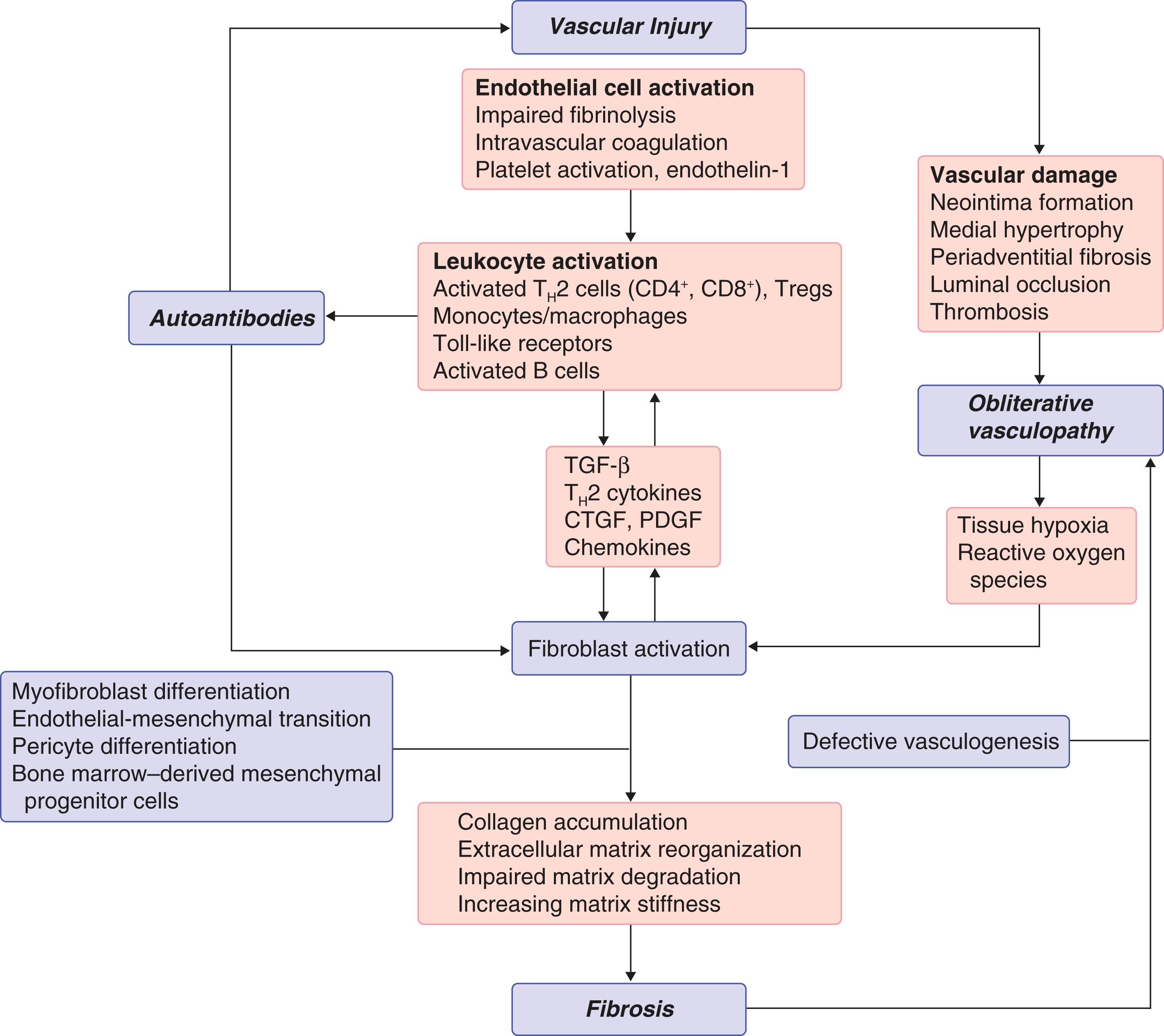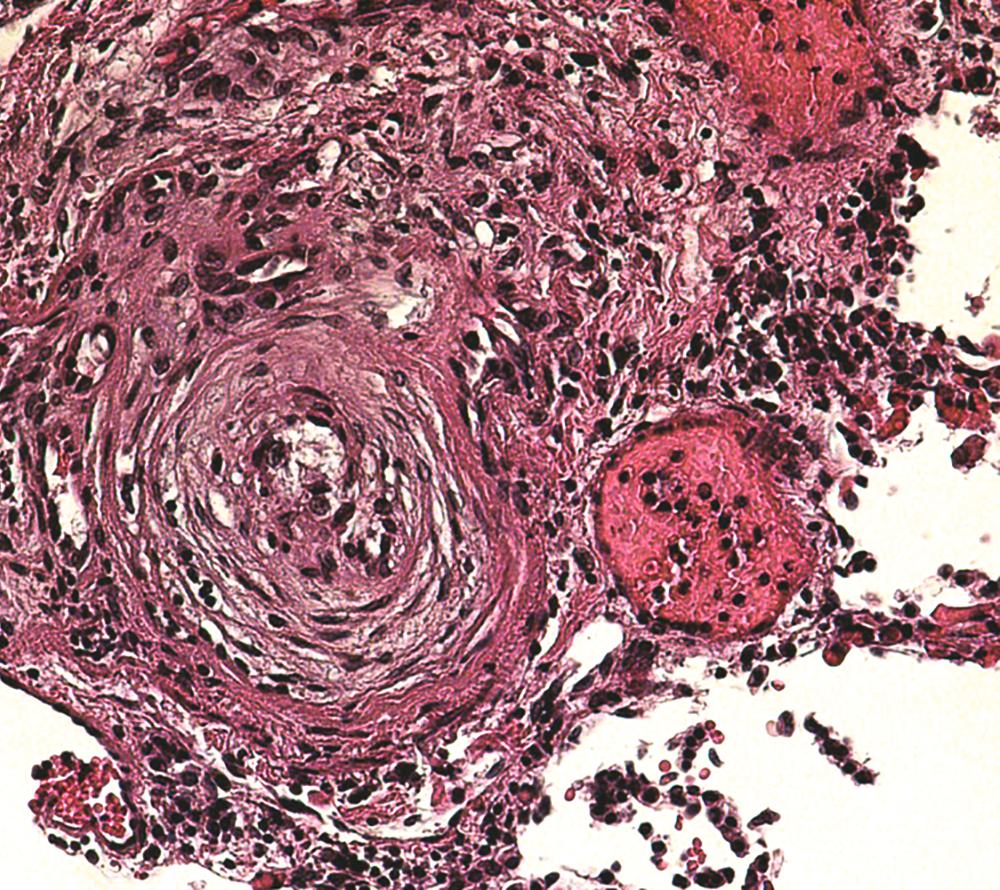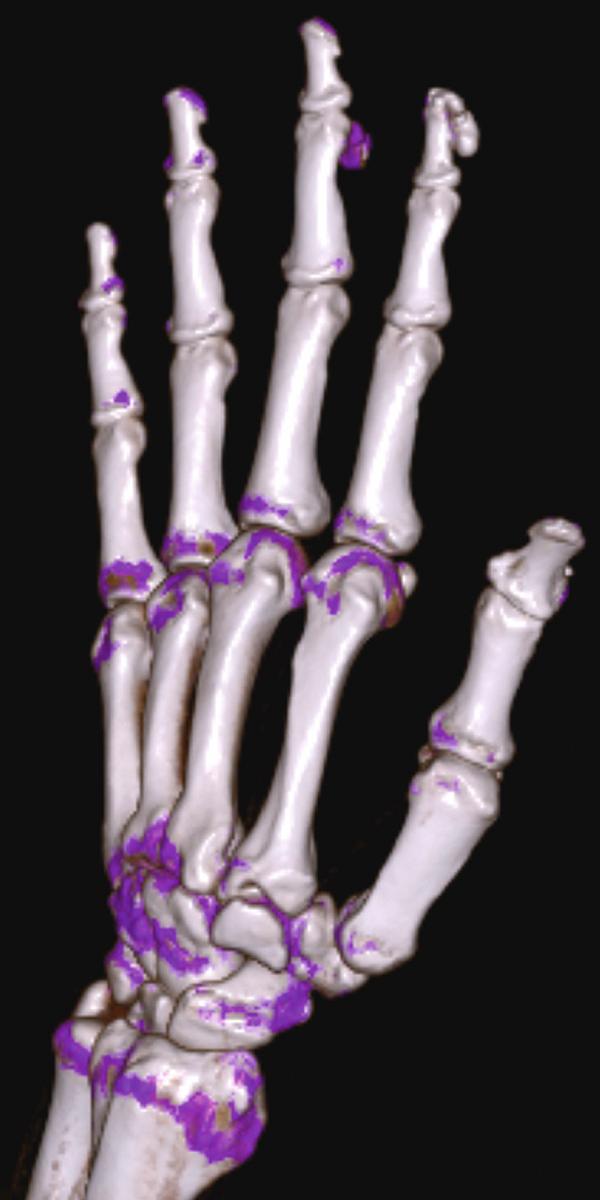Physical Address
304 North Cardinal St.
Dorchester Center, MA 02124
Systemic sclerosis , originally termed scleroderma , is a chronic autoimmune disease of unknown cause associated with considerable morbidity and mortality. The disease shows marked clinical heterogeneity, has protean clinical manifestations, and may follow a stable, indolent, or rapidly progressive course. The hallmark of systemic sclerosis is thickening and hardening of the skin (scleroderma), but the lungs, gastrointestinal tract, kidneys, heart, tendons, and ligaments are also commonly affected.
Systemic sclerosis is a sporadic disease with a worldwide distribution. It is considered an orphan disease in the United States, with an incidence of 9 to 19 cases per million per year. Systemic sclerosis shows a marked female predominance, particularly in the childbearing years. The peak age of onset is 40 to 60 years for both the limited and diffuse cutaneous forms. Blacks have a higher incidence and an earlier age of disease onset compared with Whites, and they are more likely to have the diffuse cutaneous form of systemic sclerosis associated with interstitial lung involvement and a worse prognosis.
The occupational exposure most strongly linked with systemic sclerosis is crystalline silica (sandblasting, mining, ceramic, clay, and glass manufacturing). Other tentative causal exposures include polyvinyl chloride, epoxy resins, and aromatic hydrocarbons including toluene and trichloroethylene. Certain drugs, including bleomycin, pentazocine, hormone replacement therapy, cocaine, and appetite suppressants, have been anecdotally linked with systemic sclerosis or pulmonary arterial hypertension. Although early studies implied a putative association of silicone breast implants with systemic sclerosis, large-scale epidemiologic investigations failed to establish an increased risk.
Among patients with systemic sclerosis, 1.6% have a first-degree relative with systemic sclerosis, a prevalence rate that is substantially higher than in the general population (0.026). Indeed, a family history is recognized as the strongest identified risk factor for systemic sclerosis. Additionally, patients with systemic sclerosis are more likely to have first-degree relatives with Raynaud phenomenon, interstitial lung disease, or other autoimmune diseases including multiple sclerosis, rheumatoid arthritis, and thyroiditis. Genomewide association and candidate-gene studies have identified significant genetic association of systemic sclerosis with multiple human leukocyte antigen (HLA) loci. Non-HLA risk loci associated with systemic sclerosis include STAT4, IRF4, PTPN22, TNFAIP3, TNIP-1, IRAK1, CD247 , and BANK1 , each of which encodes genes involved with immune signaling or autoimmunity. Most of these genetic risk alleles are not unique for systemic sclerosis, and are also linked with other autoimmune diseases, particularly systemic lupus erythematosus.
The protean clinical and pathologic manifestations of systemic sclerosis reflect a complex underlying biology encompassing three interrelated cardinal pathomechanistic processes: autoimmunity and inflammation, vascular injury and obliteration, and fibrosis with excessive matrix accumulation and loss of function in multiple tissues and organs ( E-Fig. 246-1 ).

The distinguishing pathologic hallmark of systemic sclerosis is the constellation of capillary loss (rarefaction) and obliterative vasculopathy coexisting with fibrosis in most organs. In early-stage disease, perivascular inflammation can be seen even before the appearance of fibrosis. The vascular lesion is characterized by intimal proliferation in the small- and medium-sized arteries, thereby resulting in luminal narrowing and obliteration, and is commonly complicated by platelet activation and hypercoagulability. In later-stage systemic sclerosis, noninflammatory fibrosis is prominent in the skin, lungs, gastrointestinal tract, heart, tendon sheath, perifascicular tissue surrounding skeletal muscle, and some endocrine organs such as the thyroid gland. Accumulation of connective tissue rich in fibrillar collagens, fibronectin, tenascin, cartilage oligomeric matrix protein, and proteoglycans disrupts normal architecture.
In the skin, dermal collagen deposition causes obliteration of the hair follicles, sweat glands, and other adnexae. Fibrosis invades the subjacent white dermal adipose layer with entrapment of fat cells (adipocytes). The epidermis is atrophic, and the rete pegs are effaced. In late-stage disease, there is a paucity of vascular and lymphatic endothelium. In the lungs, the interstitium and alveolar spaces are infiltrated with inflammatory cells in early disease. With progression, interstitial fibrosis and vascular damage, often coexisting within the same lesions, dominate the pathologic picture. Progressive thickening of the alveolar septae results in obliteration of the air spaces, honeycombing, and loss of pulmonary blood vessels.
Intimal thickening of small pulmonary arteries ( E-Fig. 246-2 ), best seen with elastin stain, underlies pulmonary arterial hypertension ( Chapter 69 ). These vascular lesions resemble the changes seen in idiopathic pulmonary arterial hypertension, but the hallmark plexiform lesions are uncommon in systemic sclerosis. In the gastrointestinal tract, pathologic changes can be found at any level from the mouth to the rectum. , Fibrosis of the lamina propria and submucosa with atrophy of the muscular layers are prominent in the lower esophagus, whereas striated muscle in the upper third of the esophagus is generally spared ( Chapter 124 ). Replacement of the normal gut architecture leads to disordered peristaltic activity with gastroesophageal reflux and dysmotility, gastroparesis, and small bowel obstruction. Chronic reflux can be complicated by esophageal inflammation, ulcerations, stricture formation, and Barrett metaplasia.

Pathologic changes in the myocardium and pericardium are common in systemic sclerosis, even in patients with no clinical evidence of cardiac involvement. Characteristic microvascular lesions include concentric intimal hypertrophy and luminal narrowing. Contraction band necrosis reflecting ischemia-reperfusion injury is prominent and may be accompanied by patchy myocardial fibrosis. In the kidneys, noninflammatory lesions occur in the interlobular arteries. Scleroderma renal crisis ( Chapter 110 ) is associated with striking changes in small renal arteries, with reduplication of elastic lamina, marked intimal proliferation, and concentric narrowing of the lumen (onion-skin), frequently accompanied by thrombotic microangiopathy with thrombosis and microangiopathic hemolysis.
Early vascular injury affects primarily the small- and medium-sized arteries and arterioles in multiple vascular beds. Endothelial cell injury and apoptosis result in altered balance of endothelium-derived vasodilatory (nitric oxide and prostacyclin) and vasoconstricting (endothelin-1) molecules, vascular permeability, and upregulation of adhesion molecules with transendothelial leukocyte diapedesis. Increased reactivity of platelets, activation of intravascular coagulation, defective fibrinolysis, and the resulting thrombosis further compromise vascular function. Injured capillaries lose their pericyte coverage and degenerate, thereby resulting in capillary rarefaction. Small blood vessels show intimal hyperplasia with thickening and reduplication of the basement membrane. Upon injury, endothelial cells undergo reprogramming through endothelial-mesenchymal transition. In the vascular media, myointimal cells proliferate, whereas the adventitial layers develop fibrosis. The net result is obliteration of capillaries, arterioles, and even large vessels, impaired blood flow and widespread tissue ischemia. Recurrent ischemia-reperfusion is associated with the generation of reactive oxygen species that further damage the endothelium.
The most characteristic and generally earliest vascular complication of systemic sclerosis is Raynaud phenomenon ( Chapter 66 ), which reflects abnormal thermal regulation of blood flow. Autonomic and peripheral nervous system changes in patients with Raynaud phenomenon are associated with impaired production of calcitonin gene–related peptide from sensory afferent nerves and heightened sensitivity of α 2 -adrenergic receptors on vascular smooth muscle cells. In contrast to primary Raynaud phenomenon (also called Raynaud disease), which is a common and relatively benign condition, secondary Raynaud phenomenon is generally progressive and frequently complicated by vascular remodeling with irreversible structural changes that result in tissue damage.
Immune dysregulation is a hallmark systemic sclerosis shares with other autoimmune diseases. In early disease, T cells, B cells, dendritic cells, and monocyte-macrophages are activated and accumulate within lesional tissues.
Tissue-infiltrating CD4 + T cells display restricted TcR receptor signatures indicative of their oligoclonal expansion in response to unknown antigens. T cells show T H 2 polarization with secretion of interleukin (IL)–4, IL-13, and IL-21, and low levels of interferon (IFN)–γ. T H 2 cytokines induce TGF-β and promote the synthesis of collagen and other extracellular matrix molecules. In early-stage systemic sclerosis, a predominant cytotoxic CD4 T cell accumulation may contribute to endothelial apoptosis.
Myeloid dendritic cells in systemic sclerosis show abnormally high secretion of inflammatory cytokines and chemokines such as CXCL. Macrophages are often prominent in early skin and lung lesion. Elevated expression of type I interferon-regulated genes (IFN signature) in systemic sclerosis is consistent with innate immune activation and may contribute to vascular injury.
Evidence of B-cell dysregulation is prominent in systemic sclerosis, and most patients have antinuclear antibodies, and a number of disease-specific autoantibodies. These autoantibodies have clinical utility as diagnostic and prognostic markers ( Table 246-1 ). Systemic sclerosis–specific autoantibodies are commonly directed against intracellular proteins, such as topoisomerase-I, centromere, and RNA polymerases I and III. Autoantibodies directed against endothelial cells or recognizing cell surface receptors (platelet-derived growth factor receptor [PDGFR], angiotensin II receptor, and endothelin-1 receptor), and other antigens, including telomere-related proteins, have been reported in systemic sclerosis. B-cell alterations are implicated in mediating both the autoimmune and fibrotic components of systemic sclerosis.
| AUTOANTIBODY FREQUENCY | SUBSET | CHARACTERISTIC CLINICAL ASSOCIATION |
|---|---|---|
| Topoisomerase-I (10-40%; also called Scl-70) |
Diffuse cutaneous (less commonly limited) | Tendon friction rubs, ILD, cardiac involvement, scleroderma renal crisis; isolated PAH rare |
| Centromere (15-40%) | Limited cutaneous | Digital ischemia, calcinosis cutis, isolated PAH, PBC; severe ILD and scleroderma renal crisis rare |
| RNA polymerase III (4-25%) | Diffuse cutaneous | Extensive skin involvement; tendon friction rubs, scleroderma renal crisis, increased cancer risk |
| U3-RNP/fibrillarin (1-5%) | Diffuse cutaneous | PAH, ILD, myositis |
| Th/To (1-7%) | Limited cutaneous | ILD, isolated PAH |
| PM/Scl (0-6%) | Limited cutaneous | Calcinosis cutis, myositis, arthritis |
| U1-RNP (5-35%) | MCTD | Severe PAH, myositis |
Fibrosis synchronously affecting the skin and multiple internal organs distinguishes systemic sclerosis from other rheumatic diseases. Fibrosis is characterized by the accumulation of a collagen-rich and rigid extracellular matrix elaborated by resident fibroblasts and myofibroblasts, and the replacement of tissue architecture disrupting normal function.
Myofibroblasts, which are smooth muscle cell–like mesenchymal cells with both contractile and biosynthetic properties, characterize all forms of fibrosis. Myofibroblasts normally appear transiently in damaged tissue to promote wound healing through production of extracellular matrix and of TGF-β, as well as contraction of the surrounding tissue. In systemic sclerosis, activated myofibroblasts accumulate within lesional tissue through one of three pathways: (1) in situ activation of quiescent resident fibroblasts, (2) reprogramming of injured epithelial, endothelial cells, and pericytes, or (3) differentiation of circulation-derived monocytic progenitor cells. Within the fibrotic tissue, activated myofibroblasts evade apoptosis.
Virtually every organ can be affected in systemic sclerosis, but the relative frequency, tempo, and severity shows considerable patient-to-patient variability. Patients with limited cutaneous systemic sclerosis commonly present with long-standing Raynaud phenomenon, limited skin involvement, and insidious progression of internal organ disease. Patients with diffuse cutaneous systemic sclerosis characteristically develop extensive skin induration and joint stiffness associated with early-onset internal organ involvement ( Table 246-2 ). However, many patients with systemic sclerosis defy easy classification, or show overlap with clinical and laboratory evidence of another autoimmune disease such as polymyositis ( Chapter 248 ), Sjögren syndrome ( Chapter 247 ), inflammatory polyarthritis ( Chapter 240 ), or systemic lupus erythematosus ( Chapter 245 ).
| CHARACTERISTIC FEATURES | DIFFUSE CUTANEOUS SYSTEMIC SCLEROSIS | LIMITED CUTANEOUS SYSTEMIC SCLEROSIS |
|---|---|---|
| Skin induration | Diffuse: fingers, extremities, face, trunk; progression rapid; tendon friction rubs | Limited to fingers, distal to elbows, face; progression slow |
| Raynaud phenomenon | Onset occurs coincident with or subsequent to skin involvement | Precedes skin involvement; often severe; associated with critical ischemia |
| Pulmonary fibrosis | Frequent, early, can be progressive and severe | Occasional, rarely severe |
| Pulmonary arterial hypertension | Occasional, commonly in association with pulmonary fibrosis | Frequent, late, may be isolated |
| Scleroderma renal crisis | Occurs in up to 15%; early | Very rare |
| Calcinosis cutis | Infrequent | Frequent, prominent |
| Characteristic autoantibodies | Anti-topoisomerase I (Scl-70), anti-RNA polymerase III | Anticentromere |
Patients with diffuse cutaneous systemic sclerosis typically present with puffy fingers, erythema, and pruritus, often accompanied by fatigue, stiffness, muscle weakness, and carpal tunnel syndrome. Raynaud phenomenon may not be present until later in the disease. Over weeks to months, the inflammatory edematous phase evolves into a chronic “fibrotic” phase with skin induration accompanied by dryness, hyperpigmentation, loss of body hair, and impaired sweating. Advancing skin changes commonly herald onset of internal organ involvement that is most rapidly progressive during the initial 4 years from disease onset. Thereafter, the risk for new organ involvement subsides.
In patients with limited cutaneous systemic sclerosis, the diagnosis is generally made at a later stage of the disease. Patients often have a long-standing history of Raynaud phenomenon, sometimes complicated by ischemic ulcerations at the fingertips. Disease course is indolent, with insidious progression of gastroesophageal reflux, mucocutaneous telangiectasia, or soft tissue calcinosis. Vascular manifestations tend to be more pronounced in limited cutaneous systemic sclerosis compared with diffuse cutaneous systemic sclerosis, whereas scleroderma renal crisis is uncommon.
Skin thickening typically starts in the distal fingers and is generally preceded by puffy fingers and hands. Skin involvement typically advances in a centripetal pattern from distal extremities. The skin may be hyperpigmented, but dark-skinned individuals may develop vitiligo-like “salt-and-pepper” changes which is most prominent on the scalp, upper back, and chest. Obliteration of eccrine and sebaceous glands decreases sweating and oil secretion, thereby causing dry and itchy skin. Facial changes include a beaklike nose, thinning and retraction of the lips, fine wrinkles (rhytids, radial furrowing) around the mouth, and occasionally a masklike facies due to reduced mobility of the eyelids, cheeks, and mouth ( Fig. 246-1 ). Decreased oral aperture (microstomia) is common and can interfere with eating and oral hygiene.

In long-standing systemic sclerosis, the skin is atrophic and tethered to the underlying tissue. Telangiectasias due to dilation of postcapillary venules in the upper dermis are prominent on the face, hands, lips, and oral mucosa. Breakdown of atrophic skin can lead to painful and nonhealing ulcerations at the extensor surfaces of the interphalangeal joints, fingertips, and bony prominences such as the elbows and malleoli. Ischemic ulcerations at the fingertip heal slowly, may become secondarily infected, and give rise to pathognomonic digital tip “pitting.” Ischemic soft tissue loss at the fingertips is associated with bony resorption of the terminal phalanges (acro-osteolysis) ( Fig. 246-2 ).

Calcinosis of the skin and soft tissues is common. Concrete deposits composed of calcium hydroxyapatite crystals vary in size from tiny punctate lesions to large conglomerate masses. They can be readily visualized on plain radiographs and precisely localized and measured with dual-energy CT imaging ( Fig. 246-3 ).

Common locations for calcinosis cutis include the hands (finger pads), extensor surfaces of the forearms, and olecranon and prepatellar bursae. Calcific deposits can ulcerate through the overlying skin, producing drainage of chalky white material, pain, and local inflammation, and may become secondarily infected.
Become a Clinical Tree membership for Full access and enjoy Unlimited articles
If you are a member. Log in here